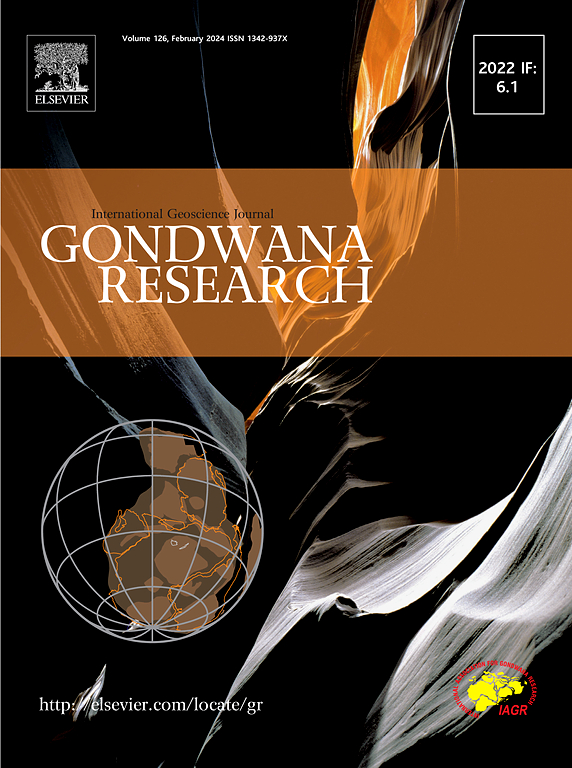Detrital zircon and rutile geochronology and provenance of early Permian lithium-rich bauxites in central Yunnan, SW China: Implications for the late Neoproterozoic–Palaeozoic evolution of the South China Block
IF 7.2
1区 地球科学
Q1 GEOSCIENCES, MULTIDISCIPLINARY
引用次数: 0
Abstract
Lithium (Li)-rich bauxites from the lower Permian Daoshitou Formation in central Yunnan, western South China Block, have significant potential for aluminium (Al) and Li exploitation. However, the provenance of these Li-rich bauxites remains uncertain. We conducted a comprehensive in situ U–Pb geochronology and trace element study of detrital zircon and rutile grains from lower Permian Li-rich bauxites and underlying Ediacaran–Carboniferous strata in central Yunnan, SW China, which yields valuable insight into the provenance of the Li-rich bauxites and the location of the South China Block during the break-up of Rodinia and assembly of Gondwana. The detrital rutile and zircon grains from the Li-rich bauxites yield similar age populations to those from Ordovician strata, highlighting the significant contribution of material from the Ordovician strata to the Li-rich bauxites. Detrital rutile grains in the Ediacaran strata have ages of 900–750 Ma, suggesting a source in the Panxi–Hannan metamorphic belt on the western margin of the South China Block. The prolonged duration (∼150 Myr) of this metamorphism implies that the South China Block was located on the margin of Rodinia during the Neoproterozoic. The asynchronous appearance of zircon and rutile populations with ages of 650–500 Ma (Cambrian) and 1050–900 Ma (Ordovician) in the South China Block suggests that the block occupied different positions during these two periods, indicating the northward migration of the block from northwest India to northeast India along the northern margin of East Gondwana during the late Cambrian–Early Ordovician. The successful application of combined detrital zircon and rutile analysis in this study highlights the reliability of this approach in elucidating the sedimentary provenance of deposits and unravelling their tectonic history.

滇中早二叠世富锂铝土矿碎屑锆石、金红石年代学及物源:对华南地块晚新元古代-古生代演化的启示
云南中部华南地块西部下二叠统稻石头组富锂铝土矿具有重要的铝、锂资源开发潜力。然而,这些富锂铝土矿的来源仍然不确定。本文对云南中部下二叠统富锂铝土矿和埃迪卡拉-石炭系下伏地层碎屑锆石和金红石颗粒进行了原位U-Pb年代学和微量元素研究,对罗迪尼亚断裂和冈瓦纳拼合时期富锂铝土矿的物源和华南地块的位置有了重要的认识。富锂铝土矿碎屑金红石和锆石颗粒的年龄群与奥陶系相近,说明奥陶系地层对富锂铝土矿的贡献较大。埃迪卡拉系地层中的金红石碎屑颗粒年龄为900 ~ 750 Ma,表明其来源为华南地块西缘的攀西-汉南变质带。该变质作用持续时间较长(~ 150 Myr),表明华南地块在新元古代位于罗丁尼亚边缘。寒武纪650 ~ 500 Ma和奥陶纪1050 ~ 900 Ma的锆石和金红石群的不同步出现表明,在这两个时期,地块处于不同的位置,表明晚寒武世—早奥陶世,地块沿东冈瓦纳北缘从印度西北部向印度东北部迁移。结合碎屑锆石和金红石分析的成功应用,说明了该方法在阐明矿床沉积物源和揭示其构造历史方面的可靠性。
本文章由计算机程序翻译,如有差异,请以英文原文为准。
求助全文
约1分钟内获得全文
求助全文
来源期刊

Gondwana Research
地学-地球科学综合
CiteScore
12.90
自引率
6.60%
发文量
298
审稿时长
65 days
期刊介绍:
Gondwana Research (GR) is an International Journal aimed to promote high quality research publications on all topics related to solid Earth, particularly with reference to the origin and evolution of continents, continental assemblies and their resources. GR is an "all earth science" journal with no restrictions on geological time, terrane or theme and covers a wide spectrum of topics in geosciences such as geology, geomorphology, palaeontology, structure, petrology, geochemistry, stable isotopes, geochronology, economic geology, exploration geology, engineering geology, geophysics, and environmental geology among other themes, and provides an appropriate forum to integrate studies from different disciplines and different terrains. In addition to regular articles and thematic issues, the journal invites high profile state-of-the-art reviews on thrust area topics for its column, ''GR FOCUS''. Focus articles include short biographies and photographs of the authors. Short articles (within ten printed pages) for rapid publication reporting important discoveries or innovative models of global interest will be considered under the category ''GR LETTERS''.
 求助内容:
求助内容: 应助结果提醒方式:
应助结果提醒方式:


